Matador Network's Blog, page 1115
April 22, 2019
Bees survived Notre Dame fire
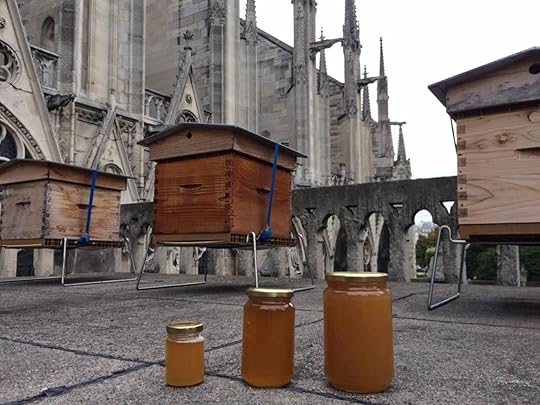
In the aftermath of last week’s devastating fire at Notre Dame de Paris, much of the discussion has revolved around the safety of the cathedral’s artworks and the rebuilding of the spire. But the fate of Notre Dame’s bee population, which numbers in the hundreds of thousands, was also cause for concern. Around 180,000 bees live in three hives on the lower roof of the cathedral first floor and were originally thought to have died in the fire. According to Nicolas Géant, however, who has maintained Notre Dame’s beehives since 2013, the beers are alive and well.
Although high temperatures during the blaze posed a big threat, Géant explained to The Associated Press how the smoke merely intoxicated them. “Instead of killing them,” he said, “the carbon dioxide makes them drunk, puts them to sleep.” Beekeepers actually use smoke often to sedate bees and access the hive.
In an interview with CNN, Géant said, “I was incredibly sad about Notre Dame because it’s such a beautiful building, and as a catholic it means a lot to me. But to hear there is life when it comes to the bees, that’s just wonderful.” he added, “Thank goodness the flames didn’t touch them. It’s a miracle!”
The hives were initially installed back in 2013 as part of an initiative to increase bee numbers across Paris. 
H/T: BBC

More like this: 7 of the world’s coolest-looking churches you didn’t know existed
The post The 180,000 bees of Notre Dame de Paris survived appeared first on Matador Network.

Blind sailor crosses the Pacific

Sailing nonstop across the Pacific Ocean is no easy task; doing it without being able to see anything is another challenge altogether. But difficulties don’t stand in the way of Mitsuhiro Iwamoto, now the first visually impaired person to make the 8,700-mile journey across the Pacific from San Diego, California, to Fukushima, Japan, without stopping. With the help of a sighted navigator Doug Smith to advise him, the 52-year-old departed on February 24 and arrived in Fukushima on Saturday.
This was his second attempt at the crossing. The first time around, in 2013, his boat struck a whale and sank in the middle of the Pacific. In preparation for the second attempt, Iwamoto participated in triathlons to stay in top physical condition.
Iwamoto lost his sight at the age of 16. According to Fox News in 2010, he said, “Life was hard… I was negative and I couldn’t accept my blindness. I didn’t know what my life is going to be. I tried to commit suicide even.” But then he realized, “I must have meaning in life, being blind. To encourage people. Not just blind people, but sighted people who lost their meaning in life.”
Iwamoto told Japan’s Kyoto News that the journey was a dream come true. “I’m the happiest person in the world,” he said.
Iwamoto and Smith undertook this journey to raise money for a charity and for efforts to fight diseases that cause blindness. 
H/T: BBC

More like this: 5 hard truths you learn about yourself when sailing
The post Blind Japanese sailor finishes nonstop crossing of the Pacific appeared first on Matador Network.

12 food and drink thrills in Japan

Japanese food has skyrocketed in popularity around the world, but discovering why it earned its status as a UNESCO Intangible Cultural Property necessitates a trip to the country itself…not that you needed much convincing.
Your tasting adventure begins the moment you step aboard your flight with All Nippon Airways, Japan’s premium airline, consistently awarded a five-star rating for its combination of omotenashi (traditional Japanese hospitality) and cuisine. Once on the plane, take a moment to relax before turning to important business: namely, planning your next meal — or 12. Here are a few suggestions for a culinary journey through Japan that showcases the best of this gourmet destination.
1. ANA’s chef-inspired menu

Photo: All Nippon Airways
Where: At 30,000 feet on your All Nippon Airways flight to Japan
Explore: ANA Business Class meals and drinks
Your first taste of the sheer diversity of Japanese cuisine comes via All Nippon Airways’ in-flight menu. The airline works with 18 Japanese and international chefs and specialists, aka The Connoisseurs, to select the finest ingredients and craft a wide range of dishes for Business Class passengers and beyond — one of many reasons to nab a premium fare.
Try a menu by Toru Okuda, chef-owner of internationally renowned Ginza Okuda, which includes a selection of fresh sashimi, lightly simmered beef, and sesame-salt grilled fish, alongside seasonal vegetables. It’s also best to start your holiday with purposeful intention: Pair the courses with some premium sake, sit back, and relish. Your culinary adventure starts here.
2. Exquisite sushi

Photo: Shutterstock/kckate16
Where: Tokyo
Explore: Flights to Tokyo
Sushi in Japan can be a life-altering experience — or at the very least, the defining moment of your trip. The capital, of course, has no shortage of top stops. If you like to be ahead of the trend, get yourself a reservation at Sushi Kinoshita, opened in June 2018. It’s the first solo venture by Chef Junichi Sato, who’s spent two decades perfecting his skills.
Finding the place is the main challenge — it’s hidden in an unremarkable apartment building. Ring the doorbell and step into the elevator as if you were visiting someone’s home. Then watch as the doors open onto a beautifully bright cypress wood interior and an eight-seat counter. If there’s space, grab a spot to observe the chefs as they prepare delicate nigiri with just the right balance of fish to rice, melding flavors and textures in perfect harmony. It’s safe to expect seasonal offerings as well as exquisite tuna.
3. Savory okonomiyaki

Photo: Shutterstock/Norikko
Where: Osaka
Explore: Flights to Osaka
Okonomiyaki is a messy-but-tasty savory pancake made from flour, yamaimo, eggs, and cabbage, usually with various hefty toppings, like pork. It’s a far cry from the delicate works of art presented as high-end Japanese cuisine, yet it’s absolutely indispensable on a trip to Osaka.
Kiji, a tiny joint tucked away under the railway arches in the busy Umeda district, is so narrow you might literally be rubbing shoulders with businesspeople grabbing their lunch, but the preparation takes a dish that began as humble street food to another level. One particularly good combo is shrimp and potato — fusing European sensibilities, the potatoes are brushed in butter, sprinkled with black pepper as they’re fried, and topped with ketchup as opposed to the typical Worcestershire sauce. Go early or expect to wait in line.
4. Star sashimi

Photo: Shutterstock/Mintra Chumpoosueb
Where: Hiroshima
Explore: Hiroshima’s restaurant district
Hiroshima is also known for its okonomiyaki, but for something different — and for one of the best dining experiences in town — head to Nikai no Onegiya Sasaki. The management refuses radio and TV coverage, claiming they’ve yet to reach their own standard of delicious food and good service, yet most diners would beg to differ.
Try to grab a counter seat where you can watch the staff at work and admire the selection of seasonal vegetables on display. Without a doubt, the sashimi is the star — each item is arranged on its own beautiful iced platter like fine artwork. The meal wouldn’t be complete, however, without some local Hiroshima sake to match the flavors of the fish.
5. Smoky yakitori
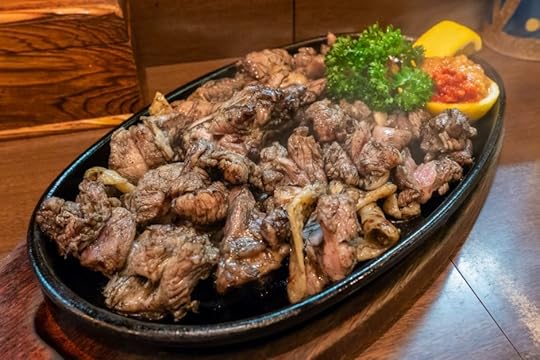
Photo: Shutterstock/Keitama Papa
Where: Miyazaki
Explore: Visiting Miyazaki’s Takachiho Shrine
In an area famed for chicken cuisine, Torimasa is a modern izakaya (Japanese-style pub) that serves headline-making yakitori, or grilled chicken skewers. They pride themselves on having almost every part of chicken imaginable on offer and assure diners of the quality — the chicken is sourced from a local producer that raises the birds free-range on a natural feed mix developed 50 years ago.
Of course, Torimasa also offers two Miyazaki classics: charcoal-grilled chicken, succulent and smoky; and chicken nanban, fried chicken served with a thick tartar sauce that balances creaminess with tanginess in just the right way. Locals would likely consider it a sin not to pair the experience with some shochu, the regional liquor of choice, distilled from sweet potatoes, rice, or barley. Try it straight or mix it with water or soda.
6. Fresh ajidon
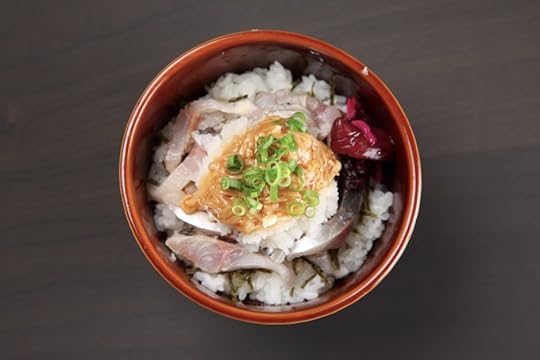
Photo: Shutterstock/UV70
Where: Hakone
Explore: An easy two-hour train ride from Tokyo on the Odakyu Railway
Hakone is known for its volcanic scenery, spectacular Mt. Fuji views, and relaxing onsen (hot springs). While the traditional ryokan (inns) offer luxurious multi-course dinners, you can grab a truly memorable lunch at Sushi Miyafuji.
A tiny place that’s been in business for over 50 years, it exudes a cozy, at-home feeling. Try the ajidon — fresh horse mackerel marinated in an original homemade sauce on top of rice. It may be hard to resist the larger set, though, which comes with torotaku-maki, a textural delight of soft, minced tuna and crunchy, pickled daikon seaweed rolls.
7. Quality beef

Photo: Shutterstock/Liiy Photo
Where: Ishigaki Island
Explore: Flights to Okinawa
Wagyu beef steals much of the international limelight, but Japan has several brands of exceptional quality beef. Ishigaki is one of the most renowned and subjected to strict conditions — the cattle must be born and raised in the Yaeyama-gun area of Okinawa for at least 20 months, and the meat is graded according to color and fat marbling, among other demanding criteria.
For one of the best and friendliest places to enjoy it, head to Sumibi Yakiniku Takesantei. Tuck your legs under the table, order all the cuts of meat that take your fancy, watch them sizzle on the grill, and then compare the textures and flavors. The fat has a lower melting point than human body temperature, so it irresistibly melts in the mouth, unleashing waves of umami. English menus are available; booking is strongly recommended.
8. Creamy unidon

Photo: Shutterstock/Funny Face
Where: Rishiri Island
Explore: Circumnavigating Rishiri Island
From snow-capped mountains to crystal waters reflecting alpine flowers, Rishiri Island looks like a postcard shot a little too perfect to be believed. Located in Japan’s far north — close to the border with Russia — the island is under 10 miles at its widest and has a population of around 5,000. The locals have lived off the sea for centuries, with sea urchin being a particularly renowned local ingredient.
For the must-try dish of the island, stop by Tairyoutei. Slide back the old wooden door and settle yourself down at a low table on the tatami mat. It won’t be long before unidon — a warm bowl of rice topped with creamy gold sea urchin — is yours. For a more unique take, order the uni dobin mushi, sea urchin broth steamed and served in a traditional dobin teapot.
9. Authentic shippoku
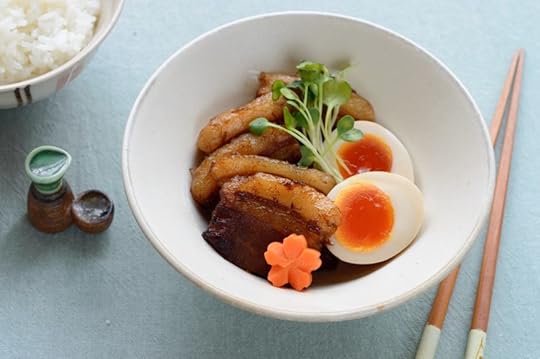
Photo: Shutterstock/Tataya Kudo
Where: Nagasaki
Explore: Visiting Nagasaki’s Omura Park
From the arrival of the Portuguese in the 16th century, Nagasaki has hosted a variety of overseas settlers — a history that’s reflected throughout its architecture and, of course, its food.
One unique form of cuisine that’s emerged here is known as shippoku, a fusion of Japanese, Dutch, and Chinese influences, all served in Chinese family-dining style. For a full course, head to Hamakatsu, where the must-try dish has to be the pork belly simmered in local sake, so tender it will dissolve in your mouth. There’s also ajisai-age, a deep-fried shrimp fritter in a hydrangea shape. Variety is all part of the fun: vinegar-marinated fish, eel sushi, beans stewed in honey, delicate fish fin soup…working through a lunch or dinner course here quickly turns into a culinary adventure.
10. Sizzling jingisukan

Photo: Shutterstock/Okimo
Where: Sapporo
Explore: Flights to Sapporo
The capital of the northern island of Hokkaido, Sapporo is known for its seafood — think luscious amounts of salmon roe and sea urchin piled on rice. But it’s also one of the few places in Japan where lamb is commonly eaten. The prime dish is jingisukan — taking its name from the Mongolian historical leader — and is a kind of lamb barbecue. Place well-marbled slices of meat on the domed griddle in front of you, throw on some vegetables, and enjoy the sizzling until done.
For a jingisukan menu you won’t find anywhere else in town, head to QueQueRe. It’s run by a chef who spent over a decade working in Europe and who brings a fusion of flavors, swapping out the traditional soy-based dipping sauce for a homemade concoction of white wine and herbs that complements the lamb perfectly. Other unusual dishes include a lamb risotto and the incredibly popular melt-in-your-mouth lamb sashimi. There’s minimal English spoken, but the staff will happily help you order.
11. Sweet kuzukuri
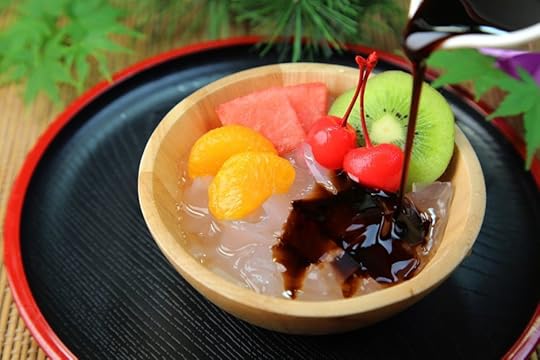
Photo: Shutterstock/Yasuhiro Amano
Where: Kanazawa
Explore: Chubu area
Kanazawa, on Japan’s west coast opposite Tokyo, is often described as a “little Kyoto,” though there are those who argue the former is actually more charming. For a taste of the old times, dine at Suginoi, one of the few remaining restaurants to serve Kaga cuisine, a traditional cooking style using local seafood, vegetables, and other ingredients. Even the dessert of kuzukuri, traditional sweetened noodles made from the root of the kudzu plant, contains water from nearby Mount Haku.
The dining experience starts, however, from the moment you arrive — the architecture, decor, and service are as important as the food. The traditional building is more than a 100 years old, with tatami rooms overlooking a garden that reflects the seasons you’ll be tasting. It’s a great way to experience all the important elements of traditional Japanese cuisine. To raise the extravagance to the max, reserve the snow crab course, a local specialty.
12. Juicy hitsumabushi
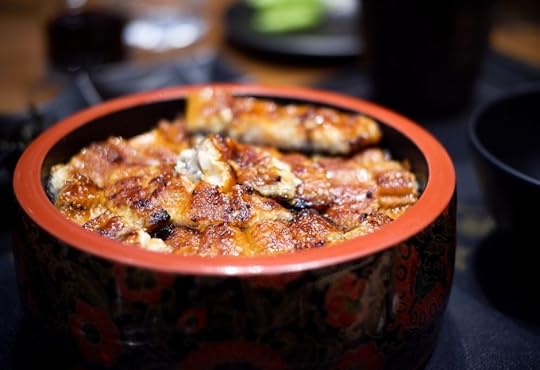
Photo: Natwarin Rungwanitcha
Where: Nagoya
Explore: Flights to Nagoya
For a uniquely Nagoya dish and some tantalizingly crisp and juicy unagi (river eel), plan to order some hitsumabushi when you’re in town. Soy sauce-flavored and charcoal-grilled, the eel is sliced into strips and served in a wooden box (hitsu) atop a bed of warm rice.
Not only is it delicious, but the eating method required is also a lot of fun: Divide your box into four, eat the first quarter plain, the second with toppings of nori seaweed, wasabi, and spring onions, the third with a light tea or dashi broth, and the last…whichever of the first three you liked best. Head to the restaurant said to be its pioneer, Atsuta Houraiken, which has been in business since 1873. Sometimes to truly elevate a tradition, you have to check in with its roots. 
The post 12 elevated food and drink experiences to have in Japan appeared first on Matador Network.

April 19, 2019
Taxidermy library in Anchorage

If you want to check out a book, you go to the nearest public library. If you want to check out a piece of taxidermy, you go to the Alaska Resources Library and Information Services (ARLIS) at the University of Alaska Anchorage campus.
The library houses hundreds of taxidermied specimens, from fawns to snowy owls, sandhill cranes, and harlequin rockfish. Unsurprisingly, it’s the only known library in the US to contain such a collection, as well as lend the pieces to anyone with an Anchorage public library card.

Photo: ARLIS
Usually, the specimens in the ARLIS collection would be found behind glass cases in a museum, but ARLIS combines the resources of several government agencies, including the Alaska Department of Fish and Game, to make them more accessible to the public.
If you’re wondering what kind of people regularly patronize the strange ARLIS collection, it’s actually not as bizarre as you think. Mainly, it’s local teachers, biologists, and researchers, who incorporate the animals into their lessons or academic work. Professional wildlife staff also use select items when doing presentations to the public. But individuals also borrow them for non-educational purposes. “We have a snowy owl,” said Rozen to Smithsonian “that has been used on several occasions as a decoration for a Harry Potter-themed party.”

Photo: ARLIS
Most of the collection comes from the Alaska Department of Fish and Game, the US Fish and Wildlife Service, and public donations. “Earlier today,” said Rozen, “someone called me and offered us a raven that he found in the wild that had been killed.”
The only item in the ARLIS not available for check-out is the black bear due to its hulking size. Check out the taxidermy catalogue to know what they have on the shelves. 
H/T: Smithsonian.com

More like this: The 7 coolest libraries around the world
The post Check out taxidermied animals at this library in Alaska appeared first on Matador Network.

Guide to Greenland's national dress
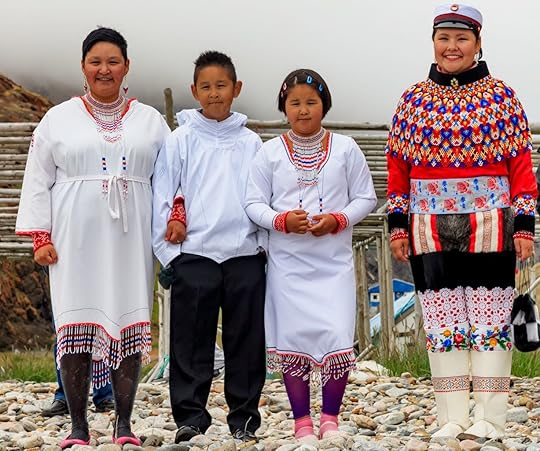
Any mention of Greenland may bring to mind a frozen terrain devoid of trees and a dreary landscape, but the reality is entirely different than what our imagination has crafted. Granted the flora is not as brightly hued as what you’d find further south, and the weather is rarely clement. But the nation is far from being uncolored or dull, and the national costume is the best proof there is to sustain this argument.
Greenland’s national dress is incredibly vibrant and intricate. Its unique aesthetic and cultural significance come from a combination of available Arctic raw materials, blended with the effects of colonialism and globalization. Today, Greenlanders work hard to maintain this element of their heritage. Although there is heated controversy regarding the attire’s future, one thing is for sure: The iconic Greenlandic national dress is a work of art that deserves the world’s attention.
The origins
[image error]
Photo: Nunatta Katersugaasivia Allagaateqarfialu, Greenland National Museum/Facebook
When Icelandic Vikings first began to colonize Greenland around the 10th century, the Inuit people who lived there wore attire made of animal skins. The Inuit used the skins from polar bears and seals to make clothes and boots, or kamiks. As with everywhere with extremely cold climates, skins served as functional protection on the freezing Greenlandic tundra and in kayaks on the water.
After the arrival of the Vikings, group after group of people came to Greenland to fish and hunt, and sometimes they stuck around. Each arriving culture inspired changes to indigenous Greenlandic attire.
Moravian Brethren missionaries living in exile from what is now Germany were the first to encourage Greenlanders to develop a national attire in approximately 1733. Greenlanders’ national clothing is a profound source of ethnic pride as the ensemble indicates their cultural independence and identity and honors the powerful role of the women who sew the clothes. All Greenlanders and anyone who feels an affiliation with Greenland are allowed and encouraged to wear the special national attire. Young children begin wearing the national dress upon their first birthday — sometimes earlier.
Contemporary Greenlanders wear their national clothing for religious, secular, and civic special occasions. Festivals are transformed into living showcases of this meaningful attire. The clothing is worn during rites of passage ceremonies like confirmation and children’s birthdays, as well as first days of school, which are very important to Greenlandic families. The attire is also worn on Christmas, Easter, and Greenland’s National Day (June 21). Greenlanders wear the clothing to greet visitors at ports of call, as well.
The attire

Photo: Jorgo Kokkinidis
In the indigenous language Avanersuaqa, a man wearing national clothing is called qaqortumaartoq, which translates to “being dressed in white.” Arnatoortoq is the term for a woman wearing festive clothing.
Greenlandic men’s national clothing tends to be more functional than decorative. They wear a white anorak (tunic) sewn of silk, satin, canvas, or, rarely, wool. Sometimes the anorak has a hood or embellished breast pockets, and it usually has side pockets that tend not to be decorated. The men wear black, green, or blue trousers and kamiks, which sometimes feature a single cuff of embroidery. The outfit might feature colorful avittat, which is sealskin that’s been dyed, cut into strips, and interspersed throughout the rest of the garments. That, however, is usually more prominent in women’s ornate dress. Men’s anoraks have hoods.

Photo: Chris Christophersen/Shutterstock
The women’s anorak goes over a blouse called a timmiaq. Greenlandic festive clothing appears to be the only national attire that gives preference to ladies’ trousers versus skirts. Their pants only reach the upper thigh where the kamik starts. Women’s kamiks are long, lined, wide sealskin boots accented with avittat and silk floral embroidery on the upper third or so.
The visually stunning yoke is a more recent addition to the outfit. Yokes are crafted with glass or pearl seed beads sourced from around the world. Over time, the yokes have grown longer, and fabric was added to embellish the anoraks. For both men and women, certain elements of the clothing indicate wealth and social status. For example, historically, more beads have meant the wearer has more prestige.
New designs, new materials
Greenlanders have constantly been exposed to new aesthetics and the global trade of objects and ideas that accompany cultural contact. While East Greenlanders’ clothing has always been simpler than that of West Greenlanders, constant interactions with newcomers changed both groups’ clothing in many ways.

Photo: Chris Christophersen/Shutterstock
In the 17th century, Dutch whalers appear to have brought glass beads, which are believed to have originated in Venice, Italy. The Inuit formerly crafted beads of bone and tusk but used them minimally. When bead production became easier through various technological inventions, seed beads were used as a trade item and distributed all over the world, from countries in Africa to North America and Greenland.
Fabrics like silk, satin, and canvas were soon introduced. They were strong and could withstand the weight of the multi-colored imported beads. Other elements began to disappear, especially certain animal skins, as populations dwindled. Today seal and other animal skins are used in national clothing, but the usage of the animals is regulated.
The Moravians introduced ornate floral embroidery patterns that are still used throughout the country, but it was the Norse who brought wool to Greenland. The yoke patterns from this region are indeed influenced by Norse heritage.
Knitting, which is understood to have arrived in Greenland in the 1920s, is big in the village of Qassiarsuk, which is populated by descendants of Leif Ericson, an explorer from Iceland (who actually stepped foot on North America well before Columbus). Greenland’s sheep are similar to Icelandic sheep, with thick long wool.
Contemporary Greenlanders import sheep’s wool fabric for anoraks and wool yarn for knitting, mostly from Denmark. There is no spinning mill in Greenland to render sheep’s wool useable in any quantity. However, Greenlandic muskox yields a fiber called qiviut, which is spun into yarn by hand and sold in some stores. Usually, qiviut comes from slaughterhouse animals; the animals aren’t generally raised for fiber.
‘Women’s magic’
Crafting the clothing has always been a gendered skill. The ability to make the attire is considered “women’s magic.” It is women who treat the skins, sew, and string glass and pearl seed beads on a silken thread to create the ornate yokes.
The same Moravian missionaries who brought the embroidery patterns recommended that women should wear different colors depending on age and marital status. Kamik color signifies a lady’s age and marital status. Although the colors vary regionally, generally older, married women can wear blue, red, or yellow kamiks. Younger girls usually wear much more detailed boots with a white background. Today, the colors and styles signify not just the wearer’s age and experience but more so his or her regional homeland.
Regionalisms
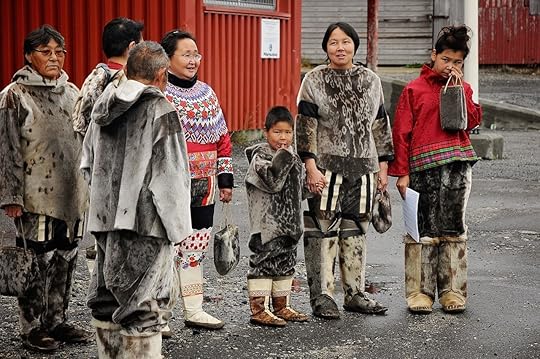
Photo: TeodorLazarev/Shutterstock
The colors and fabrics of the clothes correlate with the three distinct Greenlandic regions. In West Greenland, you see the multi-colored beaded collar and sealskin pants. That attire is called kalaallisut. In East Greenland, there are two versions of the national dress. One is mostly sealskin with a bit of embroidery or color; the other is sealskin pants and a simpler fabric top. Here, the attire is called tunumiutuut.
East Greenlanders demonstrate their regional affinity by wearing a fabric amaat, or anorak, instead of the West Greenlandic timmiaq. Increasingly, people are wearing the East Greenlandic style of kamik, made of young sealskin. Finally, the Thule area of far northwest Greenland has fox-skin pants and a black sealskin collar with long white kamik boots, sometimes made of polar bear skin. This region’s style is called arnatuut.
The New Greenlanders

Photo: RavenEyePhoto/Shutterstock
Today young Greenlanders, referred to as “The New Greenlanders,” are maintaining the traditional clothes but adding new elements from around the world — both new material and designs. National symbols are quickly being reinterpreted, and images of fashion are spread on social media. Purists argue that no one should touch the traditional symbols, but others emphasize that Greenlanders’ clothes have continually changed over the history of the land and will continue to do so, or fade away.
The gendered aspect is changing too. Today, male fashion designers proudly craft interpretations of the traditional garb and sell them to a cutting-edge international market.
Two government-sponsored schools teach the art of crafting the clothing: Kalaallisuuliornermik ilinniarfik is a two-year program in Greenland’s second city, Sisimut, and Systuen Kittat is in the capital city of Nuuk.
Where to see Greenland’s national dress
The Greenland National Museum & Archives in Nuuk features a permanent exhibit called “Lifestyle and Class Distinction.” Among other artifacts, the exhibit includes representatives of contemporary national dress. Admission to the museum is free, and it’s open most days year-round.
Examples of very early Arctic garments like mittens are on display at the University of Alaska – Fairbanks Museum of the North. These garments were crafted by the Thule people, the predecessors of the Inuit in Alaska, Greenland, and other northern regions. 

More like this: 5 iconic knitting patterns from around the world you need to master
The post Greenland’s national costume is a work of art appeared first on Matador Network.

Best beaches in Patagonia, Argentina

While South America has some of the most diverse natural landscapes in the world, among the greatest draws to the continent’s distinguished natural beauty are its beaches. Splayed along the Pacific, Atlantic, and Carribean coastlines, the most recognizable South American beaches are in Brazil, Colombia, and the like. The coastlines of Argentina don’t typically make the list of the best beaches on the continent, and most travelers certainly don’t think of Patagonia as a place to bask in the sun. This reveal is about to change all of that, unveiling the pristine, secret beaches of the Rio Negro province within Argentine Patagonia.
Argentina’s Rio Negro province and the Camino de la Costa

Photo: Stephanie Frias
Rio Negro is the northernmost province of Patagonia, a lesser-known travel destination in Argentina. The region hides an eye-popping 130-mile coastal route known as the Camino de la Costa, which spans the sparsely populated coastline between Viedma, itself 570 miles south of Buenos Aires, and Las Grutas. Ultimately, it unravels some of the cleanest, most picturesque, and remote beaches in South America. Although there are dozens of beaches on the Camino de la Costa, these are our top picks from the route.
Bahia Creek
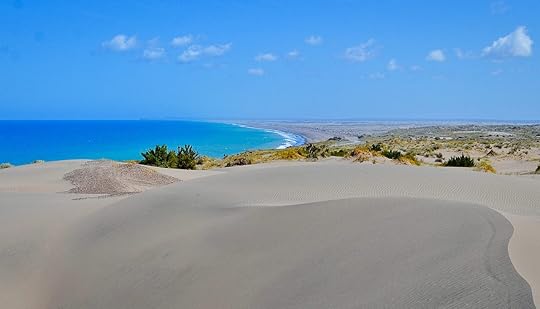
Photo: Stephanie Frias
Starting from the north, Bahia Creek is located 60 miles southwest of Viedma and has 18 miles of coastline pinched between rolling dunes and 300-foot cliffs. Harbored by the tiny village of the same name, barely 100 people call this impressive beach their home. The sand road to the beach is accessible only on foot or by an off-road vehicle at low tide. From one end to the other, travelers can explore the beaches with ATV tours offered by the local Hostel Refugio Perdido during the summer months from December to February. It’s possible to visit a native sea lion colony and see migratory birds in the coves.
This section of the route is especially idyllic for the toasty beach conditions, as the coastline is protected from the Patagonian winds, and the water is warmed up by tides hailing from Brazil. Beachgoers can enjoy swimming, snorkeling, paddle boarding, and fishing. At high tide, head up the hill for paragliding and more ATV thrills or sandboarding on the largest dunes in Patagonia. The cliff tops and dunes offer unparalleled sky-high views of the turquoise sea and expansive beaches.
Playa Las Conchillas

Photo: Stephanie Frias
The name directly translates to “Little Shell Beach,” aptly describing the shell-caked coastline, where piles upon piles of white shells carpet the isolated beaches. In the summer, you can find a beach-shack-style restaurant and lounge chairs at the beach’s entrance — but no less than 500 yards away the landscape is devoid of humans.
There are few to no residents along this eight-mile stretch of pristine seaside, offering a prime haven for non-tent campers. It is truly an oasis for getting off the grid, breathing in the pure breeze, and collecting lunch right off the shore. Come low tide, the ocean sands leave behind a gift with thousands of live clams for the taking.
Although the water is cool, it’s impossibly clear, so brave swimmers can jump in for a chance to mingle with rare dolphin species. Among them are the Commerson’s dolphin, also known as the panda dolphin, and the dusky dolphin, which is known for its aerial acrobatics.
Playa Perdices

Photo: Stephanie Frias
Playa Las Conchillas lies at the south end of Punta Verde, a peninsula that juts westward into San Matias Gulf. On the north end of Punta Verde, just over four miles away, is Playa Perdices. Here, the shell-coated beaches continue, rising over coastal hills and dipping into segregated coves decorated with sand bars and rocky enclaves.
The coastline’s segmented features allow for extreme tidal variations every 12 hours or so. At the highest point, the coves turn into stunning natural pools reaching 20 feet of depth in the center. The clear, Carribean-colored sea brings calm, warm ocean swells suitable for snorkeling, paddle boarding, swimming, and kayaking. Above the shell-covered basin, the tide brings in Patagonian penguins, various fish species, and dolphins. Then the process repeats, allowing nearly all of the water to drain until it recedes up to 150 feet, and only a trickle remains in the shallow alcoves.
Playa Piedras Coloradas

Photo: Stephanie Frias
Bringing up the tail of the list is Playa Piedra Colorados, or Beach of Red Rocks, on the opposite side of the San Matias Gulf. Although it’s a mere 2.5 miles south of the nearby city of Las Grutas, it is the most remote of the city beaches. It’s the only beach on this list with full services — in the summertime — including beach cabanas, umbrella rentals, restaurants, and lifeguards.
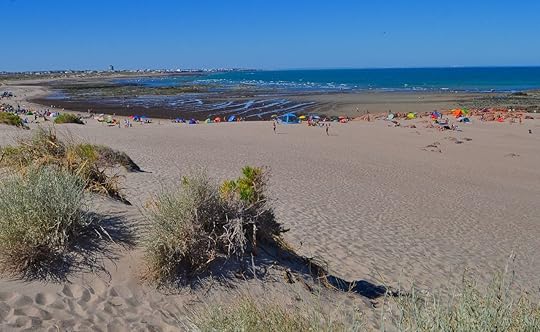
Photo: Stephanie Frias
Beyond these conveniences, the only sights of the city are in the far distance. As its name implies, a section of the beach features a crop of brick-hued rocks rising between the sea and the wide, golden beaches. The surging and receding tides offer varied landscapes where the ocean meets the land, but plenty of the coast retains dry, fluffy sand regardless of the fluctuation. Towards the west, the beach is backed by a low set of dunes offering views of the beach and land as far as the eye can see. 

More like this: The Valdes Peninsula is the absolute best place in Patagonia to see wildlife
The post Argentina’s secret aquamarine beaches hidden in Rio Negro, Patagonia appeared first on Matador Network.

Guide to live music in Manchester

If High Fidelity were a British film, Manchester is where it would have taken place. The city is the United Kingdom’s equivalent to Chicago, a major metropolis that would be too often overlooked if it didn’t have a booming music scene to fill in the colors. Indeed, the UK’s musical legacy would be far weaker without the Warehouse City’s contributions. London had the Sex Pistols, but Manchester had the Buzzcocks, who actually invited the Pistols up to Manchester for the first time. London gave us Bush, but Manchester produced Oasis — and any argument claiming Glycerine is more important than Wonderwall, well, that’s just subjective, mate. What isn’t subjective is that live music is a big deal in Manchester. The city is home to a diverse assortment of clubs and pubs playing everything from rock to house, and there’s no shortage of odes to the British punk legends. Here’s how to dip your toes in the scene during your visit.
Best places to see big-name bands

Photo: Royal Albert Hall/Facebook
Manchester is a regular tour stop for big-name artists from around the world touring the UK. Check the schedule at Albert Hall and the Manchester Arena, especially if you’re in town on a weekend — your favorite band just might be in town.
Albert Hall: There’s nothing quite like partying in a church. Albert Hall occupies an old Wesleyan chapel, swapping the pulpit for a stage that now welcomes the likes of The Oh Sees, Wilco, and other big-name artists making the rounds through the UK. The experience of theater-level shows remains authentic and approachable here, and you can have dinner and a round or two of pre-show drinks in the on-site restaurant and pub to get warmed up. If you attend a busy concert, check out the upstairs balcony for better viewing than you might find from the back of the main floor. The venue is located in the heart of the city center, within walking distance or a quick commute from many hotels and tourist attractions.
Where: 27 Peter St, City Centre, Manchester M2 5QR, UK
Manchester Arena: If you’re in town at the same time as a musical legend, odds are they’re performing at the Manchester Arena. In the coming months, Hall & Oates, Eagles, Lynyrd Skynyrd, and KISS will all perform here, with monster truck rallies, stand-up comedy, and Premier League Darts happening in between. The venue is one of the largest indoor arenas in Europe with a capacity of 21,000 people, a number sure to be put to the test when The Backstreet Boys come to town in June.
Where: Victoria Station, Hunts Bank, Manchester M3 1AR, UK
Best places for local and touring rock bands

Photo: Night & Day Cafe/Facebook
Head to Oldham Street in the Northern Quarter to catch a rock show. This neighborhood in the northern part of the city center is lined with bars, restaurants, and venues, and it’s popping most nights of the week with students, travelers, and long-time locals alike.
Night & Day Cafe: A dose of musical diversity to Oldham Street. You may see an up-and-coming indie rock band or jazz quartet one night and a DJ-fueled dance party the next. The space has hosted live music since 1991 and has established itself as a tour stop for artists working their way toward that big break. Mumford & Sons is a prime example as the group played here prior to the 2012 release of “I Will Wait,” which catapulted them to the Manchester Arena. Night & Day opens at 10:00 AM and also happens to serve a wicked eggs benedict, so if you happen to forget your credit card at the bar, there’s no shame in showing back up the next morning.
Where: 26 Oldham St, Manchester, M1 1JN
Gullivers: You get two music venues in one at Gullivers: The bigger club upstairs hosts low- and mid-level touring acts across multiple genres, and the high-end local players that support them, while the pub room downstairs is fit for more relaxed acoustic performances. There’s something going on here nearly every night, and its location in the heart of a nightlife district makes it the ideal stop for an early evening pint to plan out the night’s adventure (though there’s a solid chance you’ll end up staying put).
Where: 109 Oldham St, Manchester M4 1LW, UK
The Castle Hotel: Across the street from Gullivers, The Castle Hotel is a far more intimate space. The cap is 80 people, and even on a busy night nearly everyone is within arm’s distance of the band. Every town with a decent music scene needs a place like The Castle, where local bands can hone their stage show and work up to opening slots for touring artists. On any given night, you’re likely to catch both a band that headlines bar gigs across the UK and one that is a couple years shy of doing so. Contrary to what the name suggests, however, it’s not actually a hotel — so keep your lodging and drinking plans separate. There’ll be no quick stumble to an elevator depositing you on your assigned floor.
Where: 66 Oldham St, Manchester, M4 1LE
Rebellion Manchester: If moshing is part of your evening plans, Rebellion needs to be the evening’s central destination. Here, you can catch punk rock, metal, and various other forms of power-chord ripping rockers in the spirit of the old UK scene of the seventies and eighties. This is the type of place where you can feel the energy and passion of both the working-class bands that play here and the scene kids keeping the dream alive for another generation. There’s also a good amount of nostalgic throwback to the place thanks to an open floor, cheap beer, and a crowd that tends to get a bit rowdy. Rebellion embodies the old punk ethos in more than just its name.
Where: 2B Whitworth St W, Manchester M1 5WZ, UK
The best dance clubs in Manchester

Photo: South Nightclub/Facebook
The electronic music scene in the UK ranks among the top worldwide, with Manchester a part of its beating heart. The party goes late here, often until 4:00 AM or later, and typically picks up around midnight.
South: The best place in town to experience the madness of the electronic scene. The establishment is a dance club so true to the roots of the movement that plans for a night out here are more likely to involve a sunrise than a sunset — South doesn’t even open until 11:00 PM. The venue hosts local parties and house DJs as well as after parties for big-name events throughout town. The small, underground space offers an ideal atmosphere for electronic music and general revelry. The crowd is young and ready to hit the dance floor, and the bar typically has a drink special that keeps the party going until well into the AM. If you’re going to spend a night at South, don’t make early-morning plans that you actually intend to keep.
Where: 4A S King St, Manchester M2 6DQ, UK
Viva: Another late-night dance spot and nightclub in the truest sense. Here, the sectioned-off dance floor is the spotlight, lined with dancers and surrounded by groups taking advantage of bottle service. Glow sticks and go-go outfits are the norm here, and if there’s a chance of spotting a celebrity out for a raucous night on the town, the VIP section at VIVA is your best bet. The venue is open Friday and Saturday nights, along with special parties and events that happen throughout the week.
Where: 58 Whitworth St W, Manchester M1 5WW, UK
Mint Lounge: A solid club in its own right, Mint Lounge makes this list because of its ongoing Saturday night rager, Funkademia. This is the event you wish your college-town nightclub had. Run by a series of resident DJs who are personalities about town in their own right — radio jockeys, promoters, and long-standing innovators in the UK dance scene — this weekly throwdown brings out the best dancers and craziest outfits you’ll see anywhere in the city. Funkademia has mastered the concept of a killer party — the playlist stretches from modern house to high-beat funk to hip-hop and top 40, all blended together into a continuous mix of awesome that keeps the floor packed every Saturday until the staff forces everyone out onto the street just before the sun begins its slow climb over the Beetham Tower. The party first kicked off in 1995 and has rotated through a number of nightclubs since, with Mint Lounge being the perfect setting for its contemporary incarnation, located in the heart of the Northern Quarter.
Where: 46-50 Oldham Street, Manchester, M4 1LE 

More like this: The best places for Live Music in Belfast
The post The 9 best places for live music in Manchester appeared first on Matador Network.

Where to eat and drink at DFW

Dallas-Fort Worth is full of good places to eat, and its airport is no different. While it’s primarily stocked with the barbecue joints that the Lone Star State is so famous for, even the pickiest of eaters won’t go hungry waiting on a flight here (although vegetarians and vegans might find it a little harder than most).
Pull on your stretchy pants and get ready for your flight. These are the best places to eat and drink in every terminal at the Dallas-Fort Worth International Airport.
Terminal A
Lorena Garcia Tapas y Cocina: As the name suggests, this place is for small plates and bar eats. Options include arepas, gratin, Cuban ropa vieja, and a full bar with beer, wine, and basic cocktails. By gate A33.
Dallas Cowboys Club: A heavily branded restaurant and bar serving up Tex-Mex and burgers. Sports will, obviously, be playing, and there’s a wide selection of wine, beer, and cocktails to choose from. By gate A22.
Pappasito’s Cantina: Plenty of guac options if you’re looking for something on the lighter end of this barbecue-filled airport. There’s also Tex-Mex staples, tacos, and quesadillas. To drink, there are enough Margarita and Paloma variations to keep you well satisfied before takeoff. Pappasito’s also has an outpost in Terminal C. By gate A28.
The Salt Lick Bar-B-Que: Pull up a chair and prepare to be uncomfortably full. The Salt Lick serves up barbecue platters with bread and three sides. For breakfast, there’s big breakfast burritos and breakfast tacos. The beer list is limited, but if you like the barbecue sauce, you can buy a bottle and take it home with you. By gate A16.
Terminal B
Cousins Bar-B-Q: Another airport barbecue restaurant, but this one is above all others. It’s the airport outpost of one of Texas’s beloved smokehouses with lots of smoked meat options and all the sides you could ask for. By gates B12 and B43.
Cantina Laredo: Mexico City-inspired food like tacos, fajitas, enchiladas, and carne asada. To drink, get the Casa Rita, which is the spot’s twist on a traditional Marg. By gate B28. Also has an outpost in Terminal D.
Hickory: Airport food — even airport barbecue — has a reputation for being shuttled through security pre-cooked or almost pre-cooked. Hickory smokes some of its meats right on site. By gate B20.
Rodeo Bar: A small and quick place to jump in for a glass of wine, cocktail, beer, shot of whiskey, or shot of whiskey alongside a beer. By gate B32.
UFood Grill: Healthy eating options aren’t exactly DFW’s strength. UFood Grill is here as one shining savior with a menu that lacks any hint of a frier. By gate B40.
Terminal C
Pappadeaux Seafood Kitchen: Gulf-inspired meals like jumbo shrimp and fish served up with New Orleans cocktails like Hurricanes and Sazeracs from the bar. By gate C14.
Bleu Mediterranean Bar: Upscale Mediterranean food and a full bar for the Martini types. By gate C11.
Pappasito’s Cantina: Plenty of guac options if you’re looking for something on the lighter end of this barbecue-filled airport. There’s also Tex-Mex staples, tacos, and quesadillas. To drink, there are enough Margarita and Paloma variations to keep you well satisfied before takeoff. Also has an outpost in Terminal A.
Terminal D
Whitetail Bistro: Set aside some time, if you have it, for upscale French-Texan bistro food at Whitetail. Think quail and open-faced tri-tip sandwiches. A daily selection of macaroons are available for dessert. By gate D22.
Banh Shop: The specialty here is obviously the banh mi, but there’s a full range of Vietnamese cuisine like soups and noodle dishes. It’s good food fast. By gate D10.
Abacus: Seafood, upscale snacks like foie gras, cocktails, and wine. By gate D22.
Cantina Laredo: Mexico City-inspired food like tacos, fajitas, enchiladas, and carne asada. To drink, get the Casa Rita, which is the spot’s twist on a traditional Marg. By gate D24. Also has an outpost in Terminal B.
Cru Food & Wine Bar: The list of wines by the glass and by the bottle is long — especially for an airport wine bar. Food is on the lighter end if you’re looking for a barbecue reprieve. By gate D27.
Shinsei: An upscale sushi restaurant that’s an outpost of a beloved restaurant in Dallas proper. Along with the sushi, favorites include garlic-pork potstickers. By gate D31.
Stampede 66 Express: Modern and upscale Texan and Southwestern dishes in a casual setting from chef Stephen Pyles, who’s largely credited with bringing Southwestern food to the forefront. Come for the barbecue and Tex-Mex. By gate D27.
Terminal E
Love Shack: Texas burger and fries joint. By gate E11.
Blue Mesa Taco & Tequila Bar: The name says it all here. Fill up on tacos and tequila drinks (or wine or beer if that’s more your speed) before your flight out of Dallas. By Gate E31. 

More like this: These are the best breakfast spots in Dallas
The post Where to eat and drink at the Dallas-Fort Worth International Airport appeared first on Matador Network.

Best hotel libraries

Even for those who love books, a good library is usually not one of the most sought-after hotel amenities. But if you’re on vacation, or even traveling for business, sometimes it’s nice to have a handy resource for downtime reading material or just a place to escape the chaos of a big work trip or family vacation. Though they’re not as popular as hotel gyms, hotel libraries are still becoming a point of pride for many properties around the world. Here are 11 you should, obviously, check out.
1. JW Marriott El Convento — Cusco, Peru

Photo: JW Marriott
Don’t ever say luxury hotels with corporate name plates don’t give you a sense of place. This JW Marriott in the heart of Inca country is a converted 16th-century convent that still has walls from before the Incas’ time and countless historical artifacts. The library is almost a museum in and of itself, where in addition to books like Don Quixote and Uncle Tom’s Cabin, you’ll find floors from the ancient Killke period and hand-woven furniture from local Andean people.
2. E.B. Morgan House at Inns of Aurora — Aurora, New York

Photo: Inns of Aurora
After a taxing day of wine tasting in the Finger Lakes, it’s nice to retreat to a cozy library and enjoy a bottle of something you bought with a book. At the E.B. Morgan House you can sit back by the marble fireplace in the stately library filled with books from the personal collection of American Girl Doll’s founder Pleasant Rowland. These volumes include French-language art books and a book of woodcut images from Aurora resident and famed illustrator J.J. Lankes.
3. Il Salviatino — Florence, Italy

Photo: Il Salviatino
It’s almost like starring in your very own game of Clue — minus the murders, hopefully — when you gather with your friends in the hidden library of this restored 15th-century villa. If you can tear your eyes away from the sweeping view of the Tuscan countryside, you’ll find rich, dark leather furniture set under glowing candelabras and over 4,000 books. The wood-paneled walls and arches on the ceiling make Il Salvatino’s library the picture of Italian class and culture.
4. The Jefferson — Washington, DC

Photo: The Jefferson, Washington, DC/Facebook
America’s most stately hotel library is at The Jefferson, where the leather-bound books are a compilation of works on Thomas Jefferson’s favorite subjects. Velvet sofas and ornate rugs fill the room, giving the feeling of reading in an 18th-century mansion, just a lot warmer. You can also complement your book with a craft cocktail from Quill, The Jefferson’s renowned cocktail bar nearby.
5. Hotel Milano Scala — Milan, Italy

Photo: Hotel Milano Scala/Facebook
The Hotel Milano Scala is an opera-themed hotel in the heart of Milan’s trendy city center that has plenty of relaxing elements, from its rooftop garden to its views of the famous Duomo Cathedral. But even the lobby here oozes refined culture, with bookshelves stretching from the floor to the skylight, and leather-bound walls to relax against with a good novel.
6. Le Méridien Chambers — Minneapolis, Minnesota

Photo: Le Méridien Chambers/Facebook
If you’re one of those people who’s a sucker for hidden anything, prepare to have your mind blown by the library at Le Méridien Chambers in Minneapolis’ theater district. To find the library, you must first discover the hidden staircase in MARIN, the hotel’s restaurant. Follow that downstairs to The Library — which is not an actual library but rather a secret underground bar which serves all sorts of Prohibition-era cocktails. Inside that bar, you’ll find big mahogany walls and plush armchairs, with books on the wall behind. It’s a long way to go to find something to read. But it’s still probably better than whatever the Gideons left in the nightstand.
7. NoMad Hotel — New York City, New York
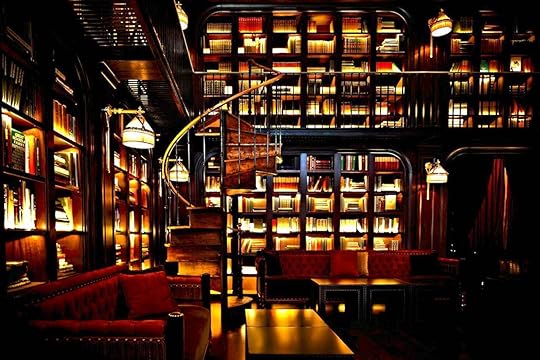
Photo: The NoMad Hotel, New York/Facebook
Libraries with spiral staircases adorned in dark-brown woods are usually reserved for Irish universities or, at the very least, trendy American cocktail bars. But the library at New York’s NoMad is big on these kinds of details, with a staircase imported from France and custom-made furniture to sit on. You’re welcome to peruse any of the books on the shelf, which cover everything from New York history to music and cocktails. And if the reading inspires you, you’re also welcome to order a drink delivered straight to your couch.
8. Conrad Cartagena — Cartagena, Colombia

Photo: Conrad Cartagena
Eating in a library is usually the sort of thing that gets you a stern dirty look from the bundled-up lady behind the circulation desk, but not at Biblioteka, the library-inspired restaurant at the Conrad Cartagena. In addition to serving up all varieties of international food — under shelves of books from around the world — the restaurant also hosts literary programs. Colombian Corner allows guests to peruse local authors’ works while drinking Colombian coffee. There’s also the Libros y Licor book club, where guests explore Gabriel Garcia Marquez’s house while learning about his life in the city.
9. Aloft Miami Aventura — Aventura, Florida

Photo: Mariott
In sunny South Florida, you don’t want to be stuck inside during your downtime. That’s why the Aloft Aventura Miami, just north of Miami, has set its library right next to the pool. Though you won’t find a ton of beach reading, you will find oversized chess, Game of Thrones Risk, Cards Against Humanity, Scrabble, and a billiards table, so you can learn to hustle pool without looking like a pool hustler.
10. Casa Palopó — Lake Atitlán, Guatemala

Photo: Casa Palopó
As 15-room boutique hotels go, you’d be hard-pressed to find a cooler library than the one at this stucco-walled gem on the shores of Lake Atitlán in Guatemala. Inside, you’re presented with a front-row seat to the gleaming blue lake, and everything from epic novels to trashy new magazines to help distract you from the view. The library’s also dotted with native pottery and a chess board near the window, creating more culture per square foot than almost any other hotel in the country.
11. Baker’s Cay — Key Largo, Florida

Photo: Baker’s Cay Resort/Facebook
Another of the modern, sleek, post-Irma resorts to open in the Florida Keys is Baker’s Cay, a beach house resort that feels like a remote escape in the middle of the ocean. A big part of the tranquility is the paperback-filled library, where long tables and ocean views alternate with towering shelves and comfy couches. It’s a cool place to relax in air conditioning after a hot day on the water — and one of the best library views you’ll ever find. 

More like this: The 7 coolest libraries around the world
The post 11 of the most beautiful hotel libraries in the world appeared first on Matador Network.

Toddler attacked by dingoes

On Thursday night, a toddler was attacked by two dingoes in a remote area of Queensland’s Fraser Island in Australia. The boy’s family had been camping in K’gari when the dingoes broke into their campervan while they slept and dragged the toddler from his bed.
According to paramedic Ben Du Toit, the parents “awoke with the toddler crying and heard the crying getting further away from the campervan.” The father ran outside, fought off the dingoes, and rescued his son from one of their jaws. Unfortunately, the toddler is still in the hospital with a fractured skull and cuts to his head and neck. He remains in a children’s hospital in Brisbane, where he is considered to be in stable condition.
Dingoes are very common on Fraser Island, where they are protected by law for unique genetic makeup. Although the animals look like cute dogs, they are wild and should not be approached or fed. Parents are advised to keep their children close when on the island.
This is the third dingo attack on the island this year. In January, a six-year-old boy was bitten on the legs and, in February, a nine-year-old-boy and his mother were also bitten. 
H/T: The Guardian

More like this: 5 places with the most dangerous animals in the world (that aren’t Australia)
The post Father rescues toddler from dingo attack in Australia appeared first on Matador Network.

Matador Network's Blog
- Matador Network's profile
- 6 followers



